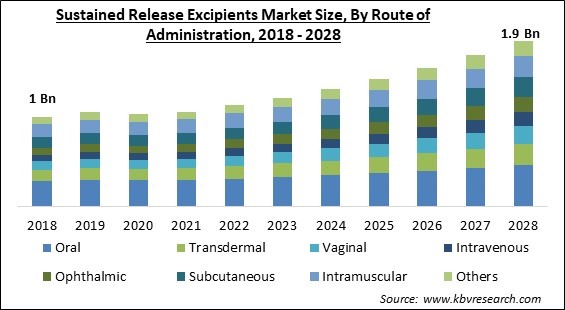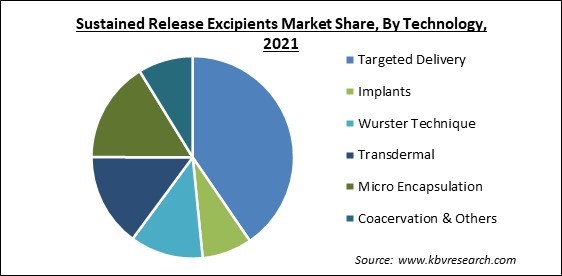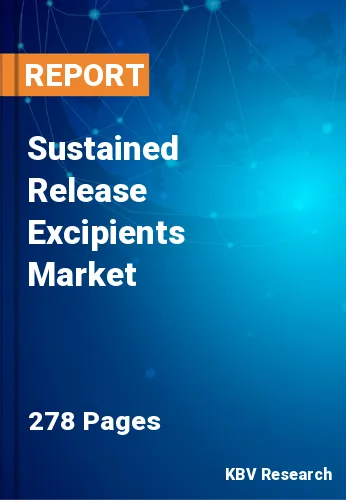The Global Sustained Release Excipients Market size is expected to reach $1.9 billion by 2028, rising at a market growth of 8.4% CAGR during the forecast period.
Sustained release excipients are one form of excipient that is added in drugs along with its active pharmacological ingredients. Sustained release excipients are pharmacologically inactive components of the medication formulation. These are formulated with an active ingredient for the purposes of long-term stabilization, bulking up solid mixtures that contain powerful active components in small amounts.

These also refer to a therapeutic improvement on the active component in the concluding dosage form, such as enhancing solubility, facilitating drug absorption, or reducing viscosity. Excipients can also be helpful during the manufacturing process to help with concerns relating to the active substance, such as assisting powder flow properties or non-stick attributes.
Additionally, it supports in vitro stability, such as preventing aggregation or denaturation over the presumed shelf life. The dosage form, mode of administration, the active ingredient, and other variables all play a role in choosing the best excipients. Using polymer layers on solid dosage forms, adding various enzyme-activated systems, polymer matrix technologies, or systems that react to changes in physiological conditions inside the formulation can all result in sustained-release behavior.
Diffusion, dissolution, osmotic pressure, preserving a hydrodynamic or hydrologic equilibrium, and ion exchange are examples of mechanisms. New strategies are currently being explored focused on nanotechnology and innovative matrix technologies, and include buoyant systems, mucoadhesive systems, and gastro-retentive drug distribution for controlled release of antiviral drugs.
Due to the closure of R&D and production facilities, the shortage of raw materials, and the lack of a possible workforce, resulting in a decrease in the total movement, including the creation of new items during the lockdown. The pandemic primarily complicated supply chain logistics, driving up the cost of producing different excipients, especially sustained-release excipients. The possibility of sustained release excipients for the production of the COVID-19 vaccine was also still being assessed at the time, taking up the opportunities for other drug development.
Patient compliance is one of the main issues faced by marketers of pharmaceutical products. A patient's willingness to take medication can significantly decline when it needs to be given multiple times each day, increasing the risk of inadequate treatment. Moreover, studies have stated that an incomplete treatment can aggravate the cause of the disease, leading to high chances of the patient succumbing to the disease again. In such cases of relapse, sometimes medicines become ineffective.
Globally, both acute and chronic diseases are becoming more common. Significant growth for medications is seen as a result of the rise in chronic disease prevalence. The increasing tendencies of side effects posed by drugs can lead to other problems. Abuse of substances has a significant negative influence on people's and their families’ health. Long-term drug and alcohol addiction can result in mental illness, chronic conditions including diabetes and heart disease, and cancer, all of which place a heavy financial cost on society.
Attaining optimal dissolution and then release profiles for poor solubility medications, managing the danger of dose dumping, and choosing biocompatible substances with the required controlled-release qualities are only a few of the difficulties that formulators may encounter. High API concentrations, which can occasionally be challenging to manufacture into the appropriate dosage formulations with acceptable characteristics, are also needed for controlled-release pharmaceuticals.

On the basis of route of administration, the sustained release excipients market is divided into oral, intramuscular, subcutaneous, transdermal, vaginal, ophthalmic, intravenous, and others. The oral route of administration procured the largest revenue share in the sustained release excipients market in 2021. It is the simplest and most used method of medication delivery. The availability of the highest active surface area enabling drug absorption in contrast to other drug delivery methods is one of the major causes behind the high share. Another significant element that contributes to the widespread adoption of oral drug delivery is the simplicity of producing tablets and capsules.
Based on product, the sustained release excipients market is categorized into gelatin and chitosan, polymers, minerals, sugars, alcohol, and others. The mineral segment witnessed significant revenue share in the sustained release excipients market in 2021. An inorganic substance with a known chemical makeup is a mineral. Minerals can be highly developed products or naturally occurring components or compounds. Calcium carbonate, which is present in limestone, magnesium stearate, which is used as a lubricant, silicon dioxide, which is most frequently associated with beach sand, and many other substances are examples of minerals.
Based on technology, the sustained release excipients market is segmented into targeted delivery, micro encapsulation, wurster technique, transdermal, implants, coacervation, and others. The targeted delivery technology witnessed the maximum revenue share in the sustained release excipients market in 2021. Targeted delivery entails sending the medication to the desired site of activity and preventing it from going to the wrong portions of the body, which increases the risk of drug toxicity. Higher patient compliance is provided by sustained release drug delivery systems, and localization of the drug is made possible by targeted drug delivery technology.
| Report Attribute | Details |
|---|---|
| Market size value in 2021 | USD 1.1 Billion |
| Market size forecast in 2028 | USD 1.9 Billion |
| Base Year | 2021 |
| Historical Period | 2018 to 2020 |
| Forecast Period | 2022 to 2028 |
| Revenue Growth Rate | CAGR of 8.4% from 2022 to 2028 |
| Number of Pages | 278 |
| Number of Tables | 450 |
| Report coverage | Market Trends, Revenue Estimation and Forecast, Segmentation Analysis, Regional and Country Breakdown, Companies Strategic Developments, Company Profiling |
| Segments covered | Route of Administration, Product, Technology, Region |
| Country scope | US, Canada, Mexico, Germany, UK, France, Russia, Spain, Italy, China, Japan, India, South Korea, Singapore, Malaysia, Brazil, Argentina, UAE, Saudi Arabia, South Africa, Nigeria |
| Growth Drivers |
|
| Restraints |
|
On the basis of region, the sustained release excipients market is analyzed across North America, Europe, Asia Pacific, and LAMEA. The Europe region acquired the highest revenue share in the sustained release excipients market in 2021. Increased R&D efforts and the existence of significant pharmaceutical businesses in the area are credited with the region's success. Due to patent expiration dates and the subsequent entry of generics, it is predicted that the region will continue to grow over the forecast period at a profitable rate.
Free Valuable Insights: Global Sustained Release Excipients Market size to reach USD 1.9 Billion by 2028
The market research report covers the analysis of key stake holders of the market. Key companies profiled in the report include BASF SE, International Flavors & Fragrances, Inc., Ashland Global Holdings Inc., Evonik Industries AG, Croda International Plc, Gattefossé, Merck Group, Pfizer, Inc., Novartis AG and AstraZeneca Plc.
By Route of Administration
By Product
By Technology
By Geography
The global Sustained Release Excipients Market size is expected to reach $1.9 billion by 2028.
Increased patient compliance leading to raised comfort are driving the market in coming years, however, Difficulties in formulations and maintaining API concentration restraints the growth of the market.
BASF SE, International Flavors & Fragrances, Inc., Ashland Global Holdings Inc., Evonik Industries AG, Croda International Plc, Gattefossé, Merck Group, Pfizer, Inc., Novartis AG and AstraZeneca Plc.
The expected CAGR of the Sustained Release Excipients Market is 8.4% from 2022 to 2028.
The Polymers market is leading the Global Sustained Release Excipients Market by Product in 2021; thereby, achieving a market value of $833.5 million by 2028.
The Europe market dominated the Global Sustained Release Excipients Market by Region in 2021; thereby, achieving a market value of $670.9 million by 2028.
Our team of dedicated experts can provide you with attractive expansion opportunities for your business.

